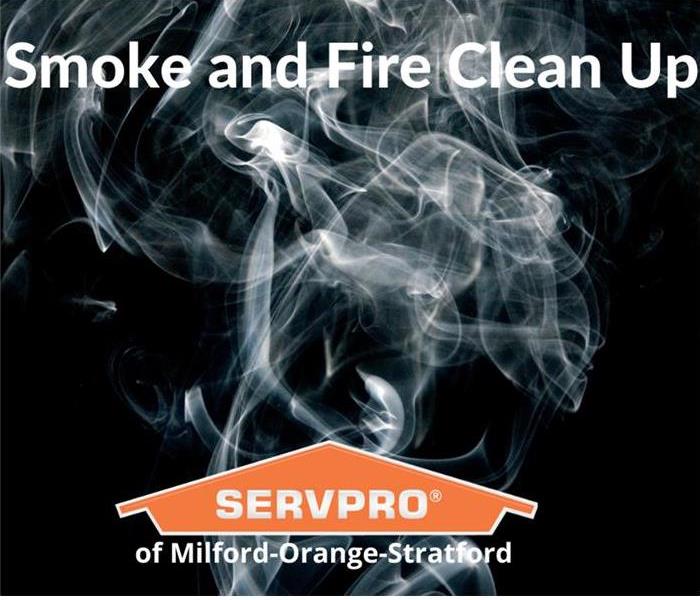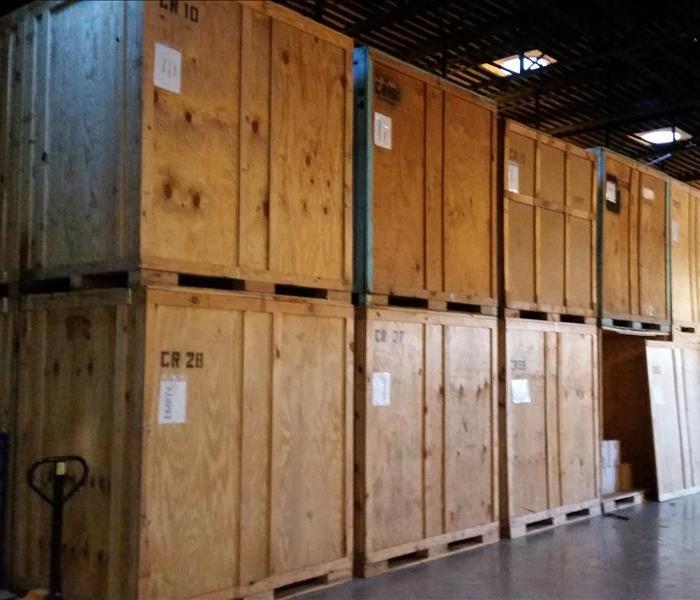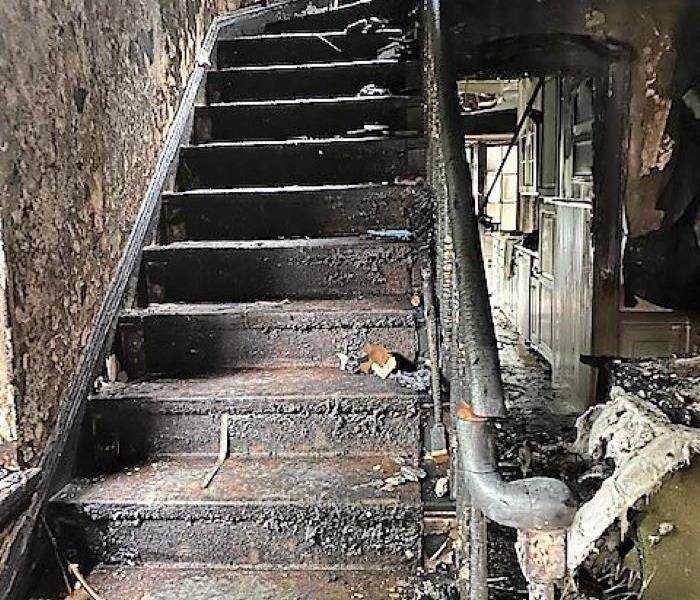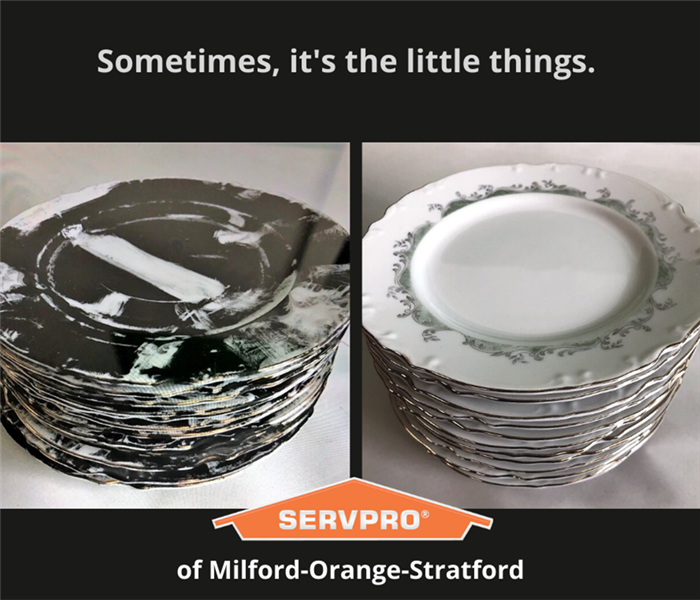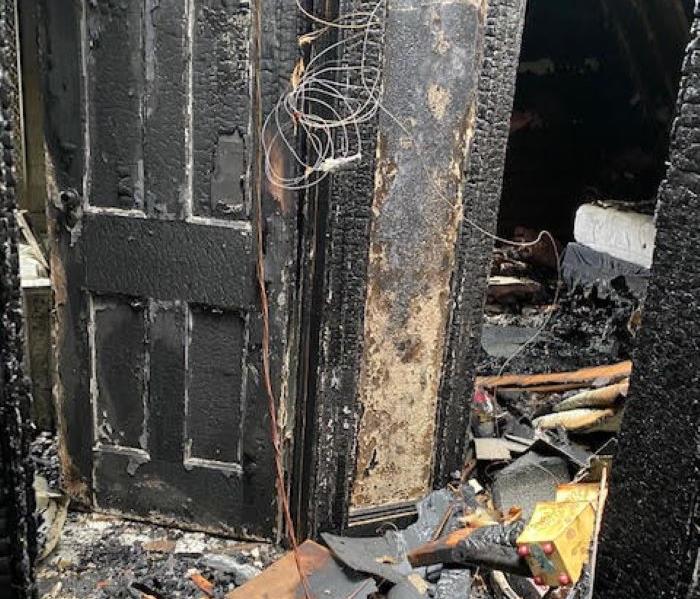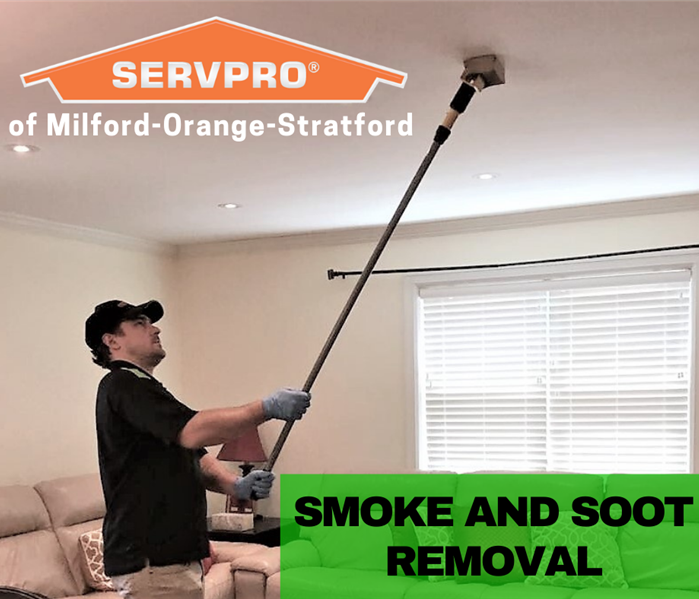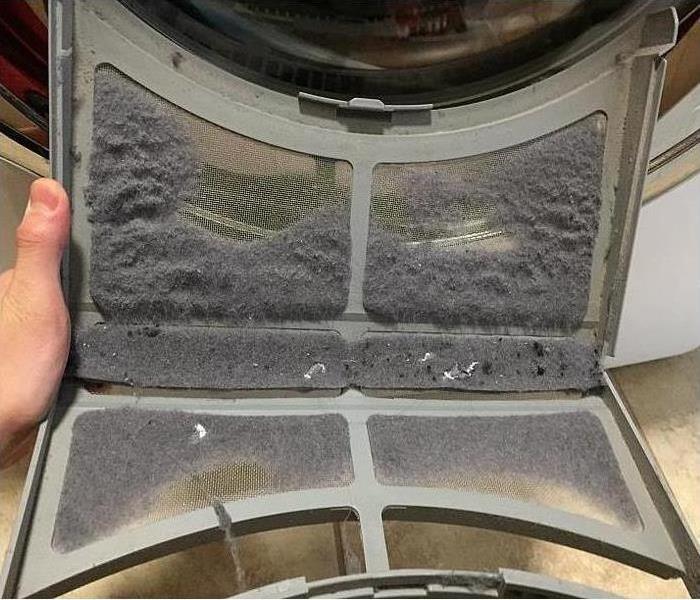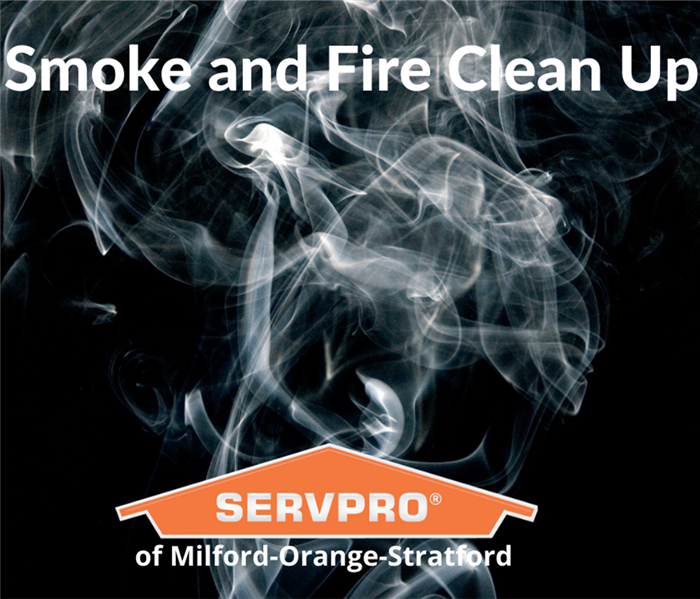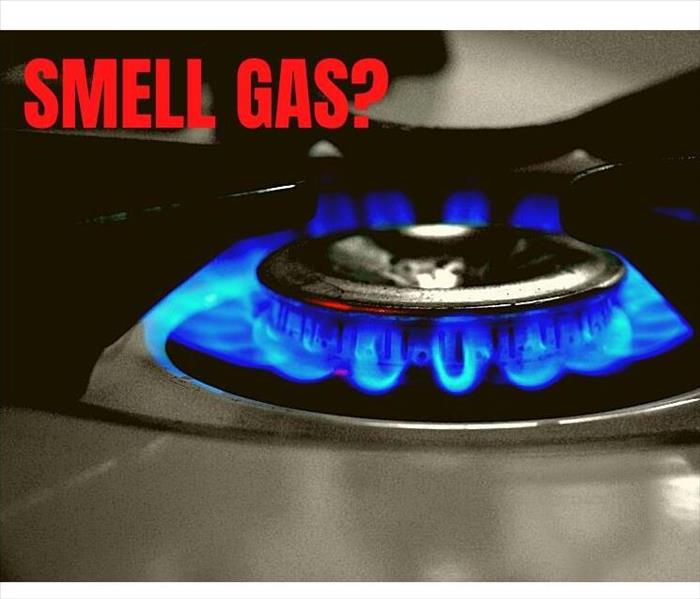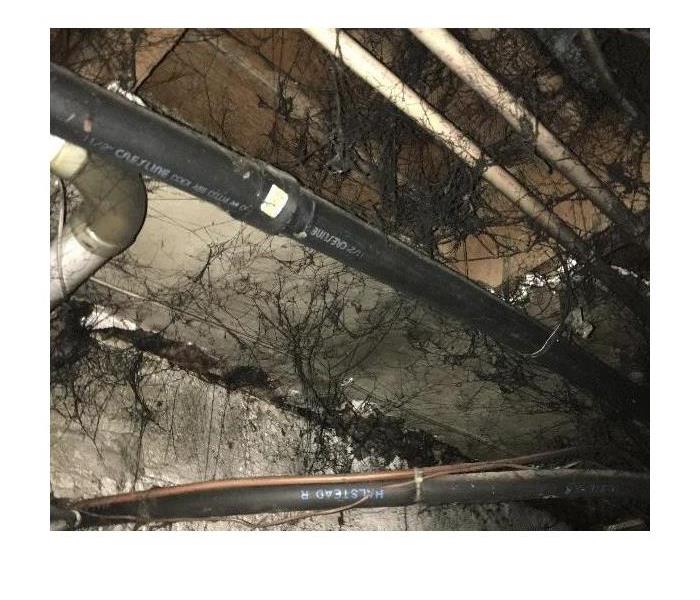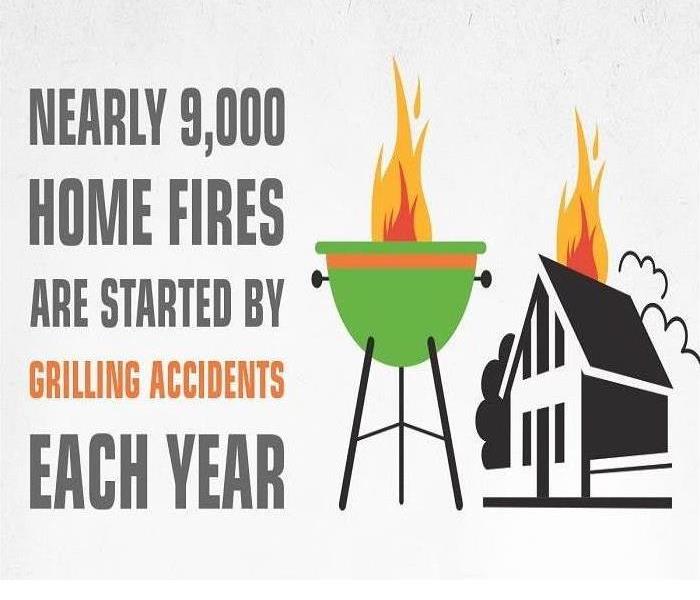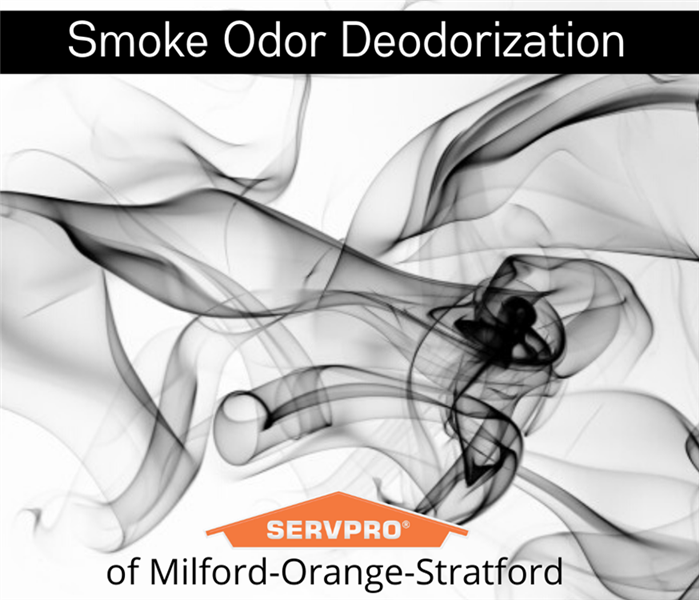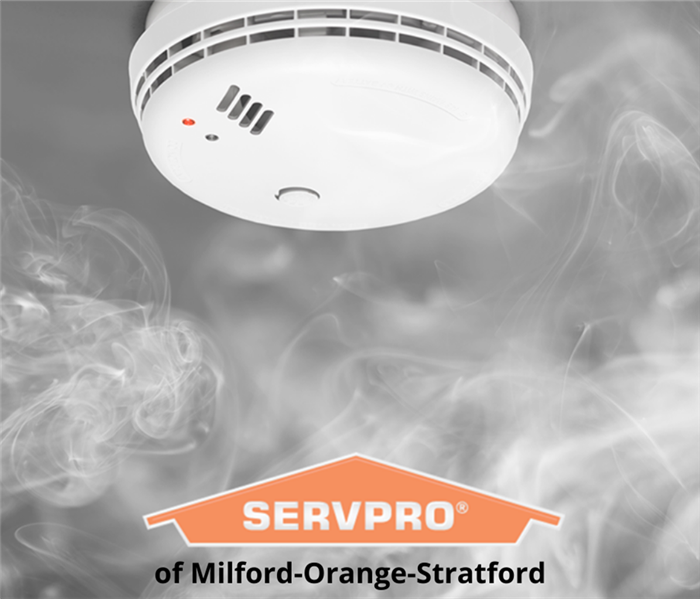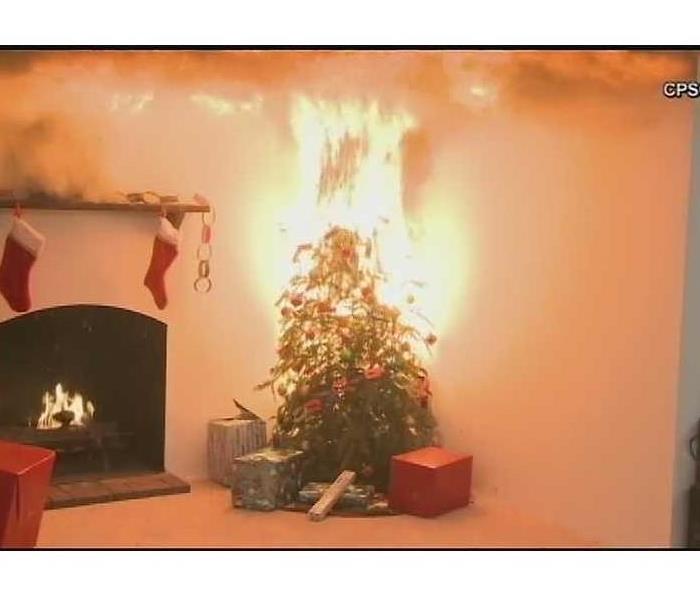Archived Fire Damage Blog Posts
The Lingering Smell After a Kitchen Fire
6/13/2022 (Permalink)
There are times when we enter a home that has had a fire and there is little visible evidence of damage other than a blackened kitchen range. However, in these cases the lingering smoke odor can be a big problem.
If you’ve ever tried to remove smoke odor on your own, however, you know that this is not an easy task. Smoke can penetrate both hard and soft surfaces, including wood floors, carpeting and even infiltrate the cavity behind walls, leaving the home with a smoky smell for years.
The professional restoration efforts of SERVPRO of Milford-Orange-Stratford ensures that the smoke damage is neutralized completely, with no scent at all left behind. Our team has a number of ways in which it accomplishes the neutralization of odorous molecules. One tool in our arsenal is the fogging machine. This chemical fog applied has no scent, but it reacts with smoke damage on a molecular level and nullifies them entirely. Ozone machines with HEPA filters are also utilized for deodorizing your home. This machine cleans the air of the foul lingering odor and removes any harmful molecules that might also still be around following your recent fire.
Don’t suffer in a smelly home after you’ve had a small kitchen fire. Our team is trained and experienced in fire damage restoration and ready to make it “Like it never even happened.”
Home fires are devastating. The restoration process doesn't have to be.
4/19/2022 (Permalink)
When your business or home has had a fire, the restoration process involves more than the structural restoration of your home.
In addition to cleaning the smoke from the air in your home and the soot off of the surfaces, SERVPRO of Milford-Orange-Stratford offers the following services:
Board-ups
In many cases in which there has been a fire, it is necessary to secure the openings of your home, such as the windows, doors and the roof. Our team uses sturdy, durable materials designed to protect homes from both the outside elements such as rain and snow as well as intrusion by outsiders. This is often one of the first actions we will take when we arrive at the job - even if it’s in the middle of the night.
Pack-Outs
After a fire, it may be necessary to move some or all of your personal belongings and furniture out of your home. This may be to protect your contents, to make the restoration and rebuild of your home easier and also in order to clean your things off site. Our franchise offers a pack out service and also has a dedicated storage facility in which we can store your items. Items such as carpeting, electronics, artwork and furniture might be restored off site by our technicians.
Inventory
When your home or business has experienced a fire, it is important to take an inventory of the contents inside prior to anything being discarded or packed up. At SERVPRO, we use a system called the Contents Claim Inventory Service (CCIS), which allows us to generate comprehensive room-by-room inventories. As we go through the items , we will categorize the contents as salvageable, non-salvageable and questionable. This allows for easier contents settlement with your insurance company.
Home fires are devastating. The restoration process doesn't have to be.
Residential Fire Damage is on the Rise in the Winter
1/25/2022 (Permalink)
We are currently restoring a home in which there was an electrical fire. These tend to be more numerous in the winter due to increased usage of lights and heating appliances. Electrical fires most often start in the bedroom of residential structures that er one and two family dwellings.
In other words, many of us are at risk of an electrical fire his winter.
The most common cause of residential electrical fires is faulty electrical outlets and appliances (typically older and outdated ones). Although there is often no warning that an outlet is faulty or appliance a danger, there are some warning signals that should not be ignored. These include frayed cords, sparks visible when using and outlet or a finicky switch.
Outdated wiring in older homes often lack the capacity to handle the electrical demands of today’s homes. Circuit breakers are designed to be triggered when circuits get overloaded by too much electricity, but outdated breaker boxes often have worn connectors that do not work, causing the system to overload and start an electrical fire.
Make sure that your lighting fixtures are always being used properly. For example, using a bulb that exceeds the wattage recommendations for a light fixture creates a fire hazard. Fabric or paper placed over a lampshade can easily ignite.
In our work, we have seen several fires that are the result of the misuse of extension cords. Household appliances such as refrigerators and dryers should be plugged directly into the outlet and not plugged into an extension cord for any length of time. Additionally, removing the grounding prong from a three prong cord creates a fire hazard. If you do not have the appropriate type of outlets for your appliances, hire an electrician to install new ones.
We’ve discussed safety concerns in regards to space heaters before however feel we cannot stress enough the importance of using them with caution. Due to their portability, space heaters are often placed way too close to combustible surfaces such as curtains, bedding, laundry baskets full of clothing, rugs and upholstered chairs and couches. Coil space heaters are especially dangerous in this regard because the coils become so hot they will almost instantaneously ignite any nearby flammable surface. However, even the newer infrared heaters pose a danger and should be used only by adults and placed in a safe space.
For information on our Fire Damage Restoration Services, please call our office at (203) 301-0500.
Cleaning the Contents of Your Home After a Fire
12/4/2021 (Permalink)
Some of the toughest jobs we respond to are house fires. It can be devastating, both physically and emotionally, for the family who has experienced such a loss. Not only is there damage from the fire itself, the smoke and soot can render many possessions unsalvageable. On top of that, water damage from fire fighting efforts adds another layer of damage. Our team knows how important it is to save whatever we can of your belongings. We have technicians trained and experienced in the art of content cleaning, which can take different forms depending on the item.
Dry-Cleaning: In order to remove smoke and soot from porous items such as clothing, furniture and drapery, we use the dry cleaning method. The soot has to be removed from the textiles before they are washed with water.
Ultrasonic: Non-porous items can go through a more vigorous cleaning than materials that soak up water. The ultrasonic treatment incorporates ultrasound and a cleaning solvent to rid your belongings of soot.
High-Pressure Water: In some circumstances, such as for larger items, our technicians opt to use high-pressure water treatment on non-porous household items.
Odor Removal: Smoke isn't the only thing that can cling to your possessions. The smell can linger after all visible signs of fire damage has disappeared. Our team may use thermal fogging or ozone treatments to make your home smelling good again.
With decades in the business, our team has helped hundreds of families back into their homes after house fires. If you are faced with such a loss, please know that we are available to help.
Puffbacks Cause a Sticky Mess!
11/15/2021 (Permalink)
With the arrival of cold weather in the Milford area, the calls coming to our office take a different tone.
Winter brings calls from homeowners who have had burst pipes and chimney fires as well as furnace puffbacks. A puffback is a messy furnace malfunction that occurs when an oil burner backfires, sending soot throughout the interior of a home. Puff backs happen when your oil burning furnace doesn't ignite when it should. This causes oil vapors to build up which results in an explosion when the igniter finally triggers. The result of this is soot and other debris is forced from the furnace's exhaust system. The soot then enters the homes heating system and gets blown throughout the home.
If you see signs of a puffback in your home, call your oil company immediately for an inspection of your furnace. If a homeowner hasn't experienced a puff back before, they might mistake the soot on their surfaces for dust and attempt to wipe it away. However, soot cannot but easily wiped away- it requires specialized cleaning by your local SERVPRO franchise.
At SERVPRO of Milford-Orange-Stratford, we have the tools, training and experience to get your home back to properly remove soot in your home. Call us at (203) 301-0500 for immediate service.
Don't Let a Turkey Fryer Cause a House Fire this Thanksgiving
10/25/2021 (Permalink)
To be honest, I’ve never fried my Thanksgiving turkey. My family has always gone the traditional route and roasted our bird in the oven. I am tempted, however, to give it a try this year because so many people swear by how amazing and flavorful a fried turkey is.
Working in the fire damage restoration business, however, I’ve seen the damage a turkey fryer can do to a home. Turkey fryer fires are more common than you’d imagine and are devastating because everything surrounding the fire is engulfed in the flames.
So, why does frying a turkey carry the risk of fire?
I know. It’s cold in Connecticut by the last Thursday of November and you may not want to be standing outside while the rest of the meal is cooking in the kitchen. But turkeys should ALWAYS be fried outside. Just because you’ve been doing it in your garage for 10 years and never had a problem doesn’t mean it can't happen to you. Because the hot oil will spray everywhere when cooking, a 10’ radius around the fryer is necessary. It quickly starts a fire when making contact with combustible materials, such as wood or fabric. If the oil touches bare skin, it can also cause severe burns.
One common mistake people make is using a frozen turkey. This is because when a frozen turkey is submerged into a pot of oil, the oil doesn’t mix with the frozen water on the turkey. Instead, heavy pockets of water will sink to the bottom of the fryer while the oil surrounding them quickly heats it beyond its boiling point. The water then evaporates, expands, and splatters the oil everywhere, including the burner. Upon hitting the burner, the beads of oil ignite into flames that spread out in all directions. If you have marinated your turkey in a brine, make sure it is fully dry prior to putting in the oil.
Measure your oil carefully, making certain that it is 4-6” below rim after the turkey is palced in it. . When you lower the turkey in, be sure to be wearing oven mitts, long sleeves, pants, and close-toed shoes. Hot oil will stick to bare skin, causing severe burns that can result in an emergency trip to the hospital.
Even a seasoned turkey fryer can have an accident that causes disaster. The turkey can slip from your hands when lowering it into the fryer or your rope-and-pulley system could break, spilling the oil everywhere and igniting a fire. The point is that something can always go wrong when frying a turkey; therefore, you should always be prepared and have a fire extinguisher by your side at all times.
We hate to see someone's holiday ruined by a house fire due to a cooking accident. But if you do have a Thanksgiving disaster, we have teams on call 24/7 - even on the holidays and are Here to Help.
Quick. Efficient. Expert. We are the Home Fire Team to Call in Connecticut.
6/18/2021 (Permalink)
Not only can the flames of a fire cause enormous damage, the ash, soot and smoke residue create a noxious environment in the home.
Both smoke and soot can create irritating odors, discolor walls or ceilings and cause breathing issues if there is a high concentration of ash left over.
Even a small home fire can cause a great amount of damage due to soot and smoke damage. We have arrived at jobs where a small kitchen fire may have caused minimal structural damage, yet smoke has managed to permeate items throughout the home and soot has covered every surface of the home. If you were to look at photos of a home with smoke damage, the damage doesn't appear substantial yet the clean up job is a big one.
SERPVRO of Milford-Orange-Stratford is IICRC Certified to restore your home after a fire. When called to a job, our crew members have the expertise and equipment to properly treat all surfaces of ash and soot. Because ash can reactive negatively to certain cleaning agents, possibly causing permanent damage and toxic fumes, this is not a job that can be done with store bought cleaning agents. We have a large production facility in which we clean and store personal belongings off site while the home restoration is ongoing.
If you have a fire, there is no time to wait- give our team a call for a quick and expert response.
Why Change Your Dryer Lint Every Time?
4/21/2021 (Permalink)
Have you ever wondered if it is really necessary to empty the dryer lint filter each time you run a load?
Sure, the label on the dryer explicitly states that you should do so but products have so many precautions these days that some seem a little exaggerated and not all of us follow every warning. However, consider that the dryer in your home depends on a 4 inch metal vent to safely exhaust that hot air outdoors. This vent can easily become blocked with dryer lint, which is highly flammable (remember the old boy scout trick of using dryer lint to quick start a fire?).
According to the U.S. Fire Administration, 2,900 home clothes dryer fires are reported each year and cause an estimated 5 deaths, 100 injuries, and $35 million in property loss. The number one cause of home dryer fires is the failure to clean the dryer vent.
Safety experts advise that you clean your dryer lint filter before AND after each load. Clean any lint from inside the filter receptacle as well to remove any lint that might have passed through. In addition, use a brush to clean the vent pipe itself every 3 months. Don’t forget to vacuum behind your dryer - it’s a common place for lint build up. Inspect the exterior vent on a regular basis - broken vent flaps as well as insect and animal nests can block the exit of the hot air.
Switching the laundry from the washing machine to the dryer is an easy chore for kids to do however they are very likely to forget to empty the lint filter. Make sure that this is stressed as an important part of the chore and double check after they've finished to make sure it's been properly done.
If you notice that your clothes are taking longer to dry than usual, that is a sign that the flow of air is restricted in your dryer. If, after inspecting and cleaning out all of the accessible areas yourself, the problem is not resolved, we advise that you have a professional come out and find the source of the problem.
As fire damage restoration professionals, we see firsthand how devastating a house fire can be. Starting the habit of cleaning out your dryer filters and vents properly will reduce your risk of a home fire.
Smoke and Fire Damage Clean Up in Milford, CT
2/16/2021 (Permalink)
Not only can the flames of a fire cause enormous damage, the ash, soot and smoke residue that remains will make the home almost noxious to live in. Both can create irritating odors, discolor walls or ceilings and cause breathing issues if there is a high concentration of ash left over.
Even a small home fire can cause a great amount of damage due to soot and smoke damage. We have arrived at jobs where a small kitchen fire may have caused minimal structural damage, yet smoke has managed to permeate items throughout the home and soot has covered every surface of the home. In the pictures, the home doesn't show much damage, yet the clean up job is a big one.
When called to a job in the New Haven County area, SERVPRO of Milford-Orange-Stratford crew members have the expertise and equipment to properly treat all surfaces of ash and soot. Because ash can reactive negatively to certain cleaning agents, possibly causing permanent damage and toxic fumes, this is not a job that can be done with store bought cleaning agents. We have a large production facility in which we clean and store personal belongings off site while the home restoration is ongoing.
Smoke odors are extremely hard to remove and can’t be done with standard equipment. Our team uses thermal foggers and other sophisticated odor removal equipment on hand to counter noxious smoke odors. We can reach into all parts of your home, including inside floors and walls.
SERPVRO of Milford-Orange-Stratford is IICRC Certified to restore your home after a fire. Call us at (203) 301-0500 if you need help bringing your home back to pre-fire condition.
Smell Gas in Your Home? Here's What to Do.
12/7/2020 (Permalink)
SUSPECT A GAS LEAK? USE YOUR SENSES
See
A white cloud, mist or fog, bubbles in still water, blowing dust, or dead or dying plants.
Smell
A distinct rotten egg-like odor.
Hear
Unusual hissing, roaring or whistling.
IF YOU SUSPECT A LEAK, DO ...
Leave
Immediately move to a safe location. Don't start your car, as a spark could ignite.
Call 911
Call 911. Don't assume someone else made the call. Report your location, including cross streets, and whether there's digging nearby.
IF YOU SUSPECT A LEAK, DON'T ...
- Smoke.
- Light a match.
- Open doors or windows.
- Use your landline or cell phone.
- Switch on/off appliances.
- Use a flashlight.
- Start a car.
- Attempt to make repairs.
In many cases, a gas leak will not result in a house fire. However, if one does occur in your home, please call us for immediate fire damage restoration service.
Keep Your Thanksgiving Safe with These Tips!
11/18/2020 (Permalink)
Thanksgiving is a day filled with family, parades, football and, of course, food! The kitchen is the heart of home, especially during the holidays when most of us in New Haven County are preparing a meal with many more recipes, in larger quantities and with more cooks in the kitchen than usual!
Unfortunately, Thanksgiving Day also has the highest number of home fires annually. In 2013, Thanksgiving Day had 1,550 reported kitchen fires, which is 230% above the average number of fires per day. Keep these kitchen safety reminders in mind as you prepare your Thanksgiving feast!
"Be on time"
With so many things on your "to do" list, guests coming and going and multiple items cooking, be sure to set timers so that you don't remember to take something out of the oven too late! (nobody likes their stuffing THAT dry!)
“Stand by Your Pan”
Have a designated cook in the kitchen at all times so that food is not left unattended. This is the most common source of kitchen fires. It only takes a moment for a kitchen fire to start and with a vigilant cook in the kitchen, catching it immediately is the key to avoiding the fire spreading.
"If you fry, don't make it too high!"
The popularity of deep frying the turkey has soared (We at Milford-Orange-Stratford haven't gone this route because we are traditionalists but we hear it's quite delicious!). An overfilled cooking pot will cause cooking oil to spill when the turkey is put in, and a partially frozen turkey will cause cooking oil to splatter when put in the pot. Even a small amount of cooking oil spilling on a hot burner can cause a large fire. Play it safe and fry your bird outside.
"For grease fires, water makes it go higher!"
Never attempt to extinguish a grease fire with water or a wet towel. Water will cause the flames to flare up and spread quickly. Turn off the stove and cover the fire with a lid if it is safe to do so, thereby removing the oxygen from reaching the fire. Use a fire extinguisher, which should be stored in a convenient kitchen location (not hidden under the kitchen sink!) If you do not have a fire extinguisher, baking soda is also effective at putting out grease fires however you do need to use quite a bit of it.
We wish all of you a Happy Thanksgiving!
Black Cobwebs in Your Home? You May Have Had a Furnace Puffback.
11/2/2020 (Permalink)
If you've walked into your home to find a thin layer of black soot covering every surface and black cobwebs in the corners of your ceiling, it's likely you've had a furnace puffback.
Although not an everyday occurrence, we receive several restoration calls a year from homeowners who have had a furnace puffback. A puffback occurs when the oil burner malfunctions. This can be because the burner doesn’t ignite immediately and a buildup of fumes causes an explosion similar to that of a car backfiring. Puff backs can also happen when debris builds up and causes an explosion when the boiler turns on. In either case, the explosion sends soot and debris through the furnace or boilers exhaust system and into your home. In our experience, the soot tends to be more widespread in forced hot air systems as the heating ducts spread the soot with same efficiency that they spread air throughout the home.
A puffback leaves a fine layer of oil based soot on all of the surfaces of a home. This includes hard surfaces such as floors, walls and furniture as well as soft furnishings such as curtains, bedding, clothing and carpeting. In fact, because it is literally blasted throughout your house, the soot from a puffback manages to find its way into every nook and cranny.
When you’ve had a puffback, you will know it!
You may first notice a black sticky film on your countertops and then realize that it is widespread throughout your home. Some homeowners will see what appears to be black spiderwebs in the corners of your rooms - this is a common way the soot collects and settles.
Attempts to remove the soot will prove futile and possibly make the damage worse. Because of its oil based nature, the residue left after a puffback requires professional restoration. The SERVPRO of Milford-Orange-Stratford team is experienced, trained and equipped to properly clean your home and it’s contents of oil and soot. The good news is that puffbacks are typically covered under your homeowners insurance policy. When you experience a puffback, call your oil burner specialist, your insurance agent and SERVPRO of Milford-Orange-Stratford for immediate service.
Grilling Tips To Keep Your Independence Day Celebration Safe!
6/22/2020 (Permalink)
Finally! Summer is arriving and we are all excited for barbecues, the beach, camping and fireworks. Nothing says summer like late nights around a fire pit with friends. Summer brings fun activities but we should also be aware of the increased risk of fire during these months. Awareness of the risks and taking caution when participating in fire related activities will keep your summer safe.
Grill Fires
Grilling is our favorite way to cook in the summer. Barbecued food tastes delicious, grilling keeps the heat outside on a hot summer day and there are no pots to clean afterwards. It's a win-win-win if it all goes right. However, 5,700 home related grill fires occur each year – the majority of which occur between May and August.
Take preventative measures by:
- Inspecting your grill’s condition before the grilling season begins. Clean the grill, the drip pan, and anything that could have grease on it from previous barbecue dinners. Inspect each part of your barbecue to make sure everything is attached properly.
- Make sure that your grill is a safe distance from your house – 10 feet is recommended. I've personally experienced how quickly the vinyl siding on a home can melt from a barbecue. Do not use the grill in a garage, breezeway, carport, porch, or under a surface that can catch fire.
- Be prepared for a fire, as grease and fat are likely to catch on fire. Keep baking soda in a waterproof container near the grill in case a grease fire breaks out.
Air Conditioning Fires
According to the National Fire Protection Association, in 2010, air conditioning, fans or related equipment were involved in an estimated 7,400 reported U.S. home structure fires, with associated losses of 29 civilian deaths, 249 civilian injuries and $207 million in direct property damage. These fires usually begin with the ignition of a wire or cable insulation. It’s not just the AC that catches on fire, if your AC heats up, flammable materials near your unit can catch on fire. Fires are most likely to occur when it’s hottest outside—between 2 and 8 p.m.
- Inspect your air conditioner’s wiring systems each year to prevent these types of fires. Consider the safety concerns of purchasing an older or used air conditioning unit.
- Also, find ways to use the AC less during the day. Not only will you save money, you can save your home from a potential fire. Using fans, keeping windows open during the night, and closing blinds during the day are just some ways you can keep your house cool without AC.
We're looking forward to seeing everyone out at the beach and grilling out in Milford this summer! Stay safe and have fun!
Small Kitchen Fires Can Leave a Big Stink in Your Home
4/27/2020 (Permalink)
There are times when we enter a home that has had a fire and there is little visible evidence of damage other than a blackened kitchen range. However, in these cases the lingering smoke odor can be a big problem.
"Oh well", a homeowner might think, "I’ll just light a candle or spray some air freshener and eventually the smell will be gone. No need to go through the trouble of professional cleaning."
If you’ve ever tried to remove smoke odor on your own, however, you know that this is not an easy task. Smoke can penetrate both hard and soft surfaces, including wood floors, carpeting and even infiltrate the cavity behind walls, leaving the home with a smoky smell for years.
The professional restoration efforts of SERVPRO of Milford-Orange-Stratford ensures that the smoke damage is neutralized completely, with no scent at all left behind. Our team has a number of ways in which it accomplishes the neutralization of odorous molecules. One tool in our arsenal is the fogging machine. This chemical fog applied has no scent, but it reacts with smoke damage on a molecular level and nullifies them entirely. Ozone machines with HEPA filters are also utilized for deodorizing your home. This machine cleans the air of the foul lingering odor and removes any harmful molecules that might also still be around following your recent fire.
Don’t suffer in a smelly home after you’ve had a small kitchen fire. Our team is trained and experienced in fire damage restoration and ready to make it “Like it never even happened.”
Smoke Detector Effectiveness: Proper Placement and Mounting
2/24/2020 (Permalink)
Thanks to public safety awareness campaigns and building codes,most Connecticut households have a smoke detector in their homes.
Unfortunately, many homes still have an inadequate number of detectors and some of those may be mounted incorrectly. An improperly placed smoke detector can affect the devices ability to sense smoke quickly and put your home at risk of a fire.
Because modern furnishings – from appliances to bedding to carpeting- are primarily made from synthetic materials, house fires spread faster than in the past, when furnishings were from natural materials. This creates a need for more detectors throughout the home in order to give everyone time to escape. The National Fire Alarm and Signaling Code requires an alarm inside and outside of every sleeping room as well as on each floor of a home, including the basement.
Smoke detectors might also be installed in an ineffective place in a room. When placed on a wall, it should be between 4" and 12" from the ceiling. When on a ceiling, it should be 4" from the adjoining wall, to avoid the "dead space", as seen in our graphic to the right. If you have ceilings that are pitched, install the alarm within 3 feet of the peak but not within the apex of the peak (four inches down from the peak). In a basement, the best place to install your alarm is at above the bottom step. Avoid installing near doors, air ducts and windows, as they might interfere with detection.
Most of the smoke detectors found on store shelving today have a permanent, non removable lithium battery that will last ten years. This removes the need to replace the battery when it starts beeping – or worse, the battery being removed and not replaced. Of course, the detector itself will require replacement after ten years. When the alarm starts chirping at the end of its lifespan, that is your signal to replace it.
In our work as fire damage restoration professionals, we have seen the devastation that a house fire can cause. It's heartbreaking to see a home and all the contents that were very sentimental to those who lived there destroyed.
Take the time today to check your smoke detectors and make sure that they are properly placed, that there are enough of them and that they are in working order.
Don't Let Your Holiday Go Up in Flames- Enjoy Your Live Christmas Tree Safely
12/9/2019 (Permalink)
Connecticut has an abundance of "cut your own tree" farms as well as a number of retailers selling trees in parking lots throughout New Haven County. While live trees are part of the Christmas tradition, they also bring a potential hazard into your home.
Choosing the right kind of tree, and caring for it properly, will help reduce your risk of having a Christmas tree fire in your home this winter.
- Buy a tree that is fresh. If you cut your own tree, this isn’t an issue however if you purchase a tree from a retailer, be sure that your tree is fresh. Make sure the bottom of yours is sticky with resin. The needles should be green and supple and stay firmly attached to the branches if you tug on them or tap the tree gently on the ground. Tip: The earlier in the season you buy a tree from a lot, the fresher it will be.
- Hydrate! A dry tree is a fire hazard. A real one needs water at least once or twice daily during the first couple of weeks.
- Choose a safe location. Set your tree up in a safe place. Keep your tree away from fireplaces, radiators or electric heaters.
- Check your lights. Make sure your strands of light do not have any fraying wires, bare spots or broken bulbs. Follow manufacturers instructions on how many strands should be strung together and do not overload them.
- Dispose of your tree. Although you may not want the Christmas season to end, it is important to dispose of your Christmas tree shortly after the holiday. Despite watering, the tree will continue to die and grow dry and brittle as it ages.
Christmas tree fires are one of the most devastating restoration calls our office receives. Place your tree in the right location, keep it watered, use lights in good condition and dispose of it quickly after the holidays to help keep your holiday a celebration, not a disaster.
Residential Electrical Fires are at Their Peak in the Wintertime
11/19/2019 (Permalink)
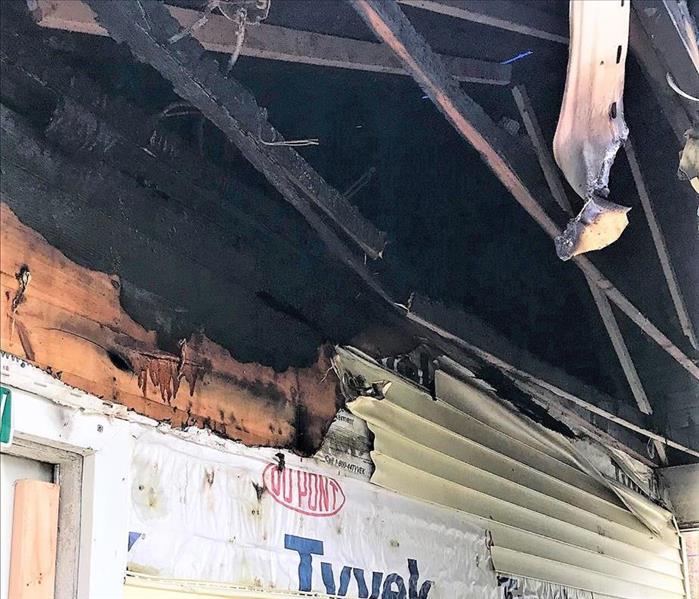 An electrical fire in this New Haven County home required the fire damage restoration services of SERVPRO of Milford-Orange-Stratford
An electrical fire in this New Haven County home required the fire damage restoration services of SERVPRO of Milford-Orange-Stratford
We are currently restoring a home in which there was an electrical fire. These tend to be more numerous in the winter due to increased usage of lights and heating appliances. Electrical fires most often start in the bedroom of residential structures that er one and two family dwellings.
In other words, many of us are at risk of an electrical fire his winter.
The most common cause of residential electrical fires is faulty electrical outlets and appliances (typically older and outdated ones). Although there is often no warning that an outlet is faulty or appliance a danger, there are some warning signals that should not be ignored. These include frayed cords, sparks visible when using and outlet or a finicky switch.
Outdated wiring in older homes often lack the capacity to handle the electrical demands of today’s homes. Circuit breakers are designed to be triggered when circuits get overloaded by too much electricity, but outdated breaker boxes often have worn connectors that do not work, causing the system to overload and start an electrical fire.
Make sure that your lighting fixtures are always being used properly. For example, using a bulb that exceeds the wattage recommendations for a light fixture creates a fire hazard. Fabric or paper placed over a lampshade can easily ignite.
In our work, we have seen several fires that are the result of the misuse of extension cords. Household appliances such as refrigerators and dryers should be plugged directly into the outlet and not plugged into an extension cord for any length of time. Additionally, removing the grounding prong from a three prong cord creates a fire hazard. If you do not have the appropriate type of outlets for your appliances, hire an electrician to install new ones.
We’ve discussed safety concerns in regards to space heaters before however feel we cannot stress enough the importance of using them with caution. Due to their portability, space heaters are often placed way too close to combustible surfaces such as curtains, bedding, laundry baskets full of clothing, rugs and upholstered chairs and couches. Coil space heaters are especially dangerous in this regard because the coils become so hot they will almost instantaneously ignite any nearby flammable surface. However, even the newer infrared heaters pose a danger and should be used only by adults and placed in a safe space.
For information on our Fire Damage Restoration Services, please call our office at (203) 301-0500.
When Your Home is Covered in a Layer of Soot.
11/12/2019 (Permalink)
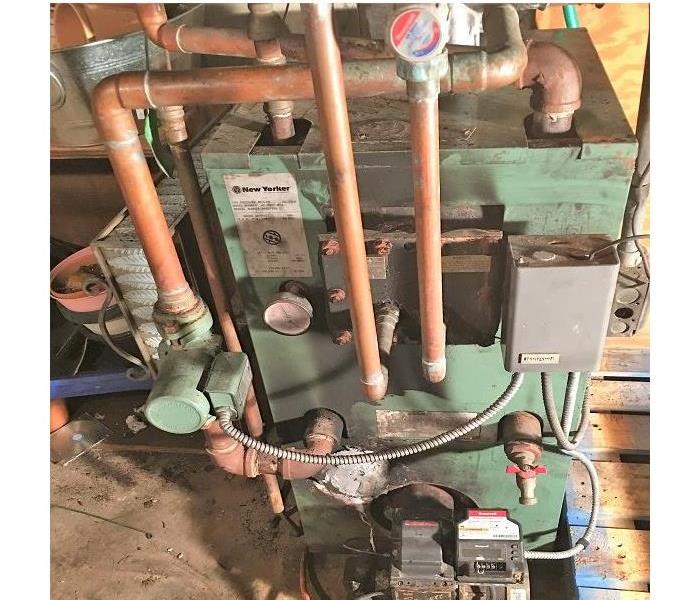 When a furnace malfunctions, a layer of soot can be sent throughout the home, leaving a sticky, difficult to remove mess.
When a furnace malfunctions, a layer of soot can be sent throughout the home, leaving a sticky, difficult to remove mess.
With the arrival of cold weather in the Milford area, the calls coming to our office take a different tone.
Winter brings calls from homeowners who have had burst pipes and chimney fires as well as furnace puff backs. A puffback is a messy furnace malfunction that occurs when an oil burner backfires, sending soot throughout the interior of a home. Puff backs happen when your oil burning furnace doesn't ignite when it should. This causes oil vapors to build up which results in an explosion when the igniter finally triggers. The result of this is soot and other debris is forced from the furnace's exhaust system. The soot then enters the homes heating system and gets blown throughout the home.
After a puffback, the contents of your home will be covered with a fine film of soot and soot cobwebs. Our crew observes that the damage is greater in homes with forced air heating or HVAC systems as they provide a pathway for the particles to disperse through the house.
If you see signs of a puffback in your Ansonia home, call your oil company immediately for an inspection of your furnace. The mechanical failure that caused the event will require repair. If a homeowner hasn't experienced a puff back before, they might mistake the soot on their surfaces for dust and attempt to wipe it away. However, soot cannot but easily wiped away- it requires specialized cleaning by your local SERVPRO franchise. Puffback residue cannot be cleaned up using traditional methods. Professional cleaning utilizes a treatment that is waterless and absorbs the soot in order to removes it. Draperies and carpeting requires chemical cleaning to remove the sticky soot.
Fortunately, this damage is covered under most homeowner's insurance policies. Our franchise also provides emergency heating while your furnace is being repaired or replaced. At SERVPRO of Milford-Orange-Stratford, we have the tools, training and experience to get your New Haven County home back to normal and properly remove soot in your home. Call us at (203) 301-0500 for immediate service after a puffback.
National Preparedness Month: "Make a Plan"
9/11/2019 (Permalink)
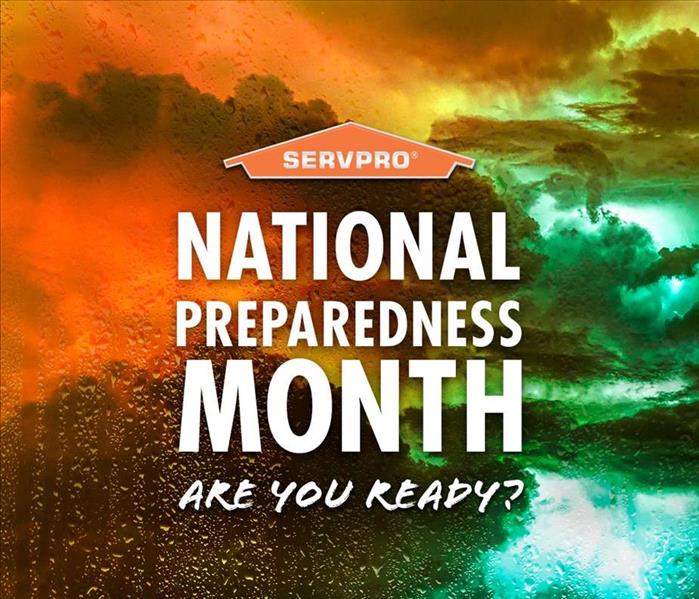 Make a plan!
Make a plan!
The theme for week 2 of National Preparedness Month is "Make a Plan".
Here's the thing, it’s just not a high priority to many people because we really don’t believe a disaster will happen to us. We are all guilty of this. However, in our work, we see the reality of what a fire or flooding disaster can inflict on a family.
So, please take the time to make a plan – especially those with children, disabled and elderly family members in your home.
Start the conversation over dinner. Discuss what kind of emergencies could possibly happen that would require a plan. What if a storm comes while your children are at school? What if there is a fire in your house? Or their school bus has an accident? It’s important to empower children with the knowledge of what your families plan is without scaring them. An excellent guide to assist you in achieving this is available at ready.gov/kids.
Practice your fire escape plan by having a home fire drill at least twice a year with everyone in the home. Don’t forget to include your pets in this exercise, as they will be a concern if an actual event happens. You can practice evacuating in your car as well. Many people have “bug out bags” with basic supplies ready in case of emergency.
We love the technology that is available to help in disasters. There are group texting apps that can be downloaded that will keep your family and circle of friends easily in contact in case of an emergency. You can also download the FEMA app, which will give you weather alerts and necessary emergency updates.
If you have a person in your home who relies on electrical medical equipment, contact your power company to get on a “priority reconnection service” list.
Look, it takes a few hours every year to work on your plan so set the time aside this week and practice!
Using Three Pronged Electrical Adaptors Can Put Your Home at Risk of Fire
3/25/2019 (Permalink)
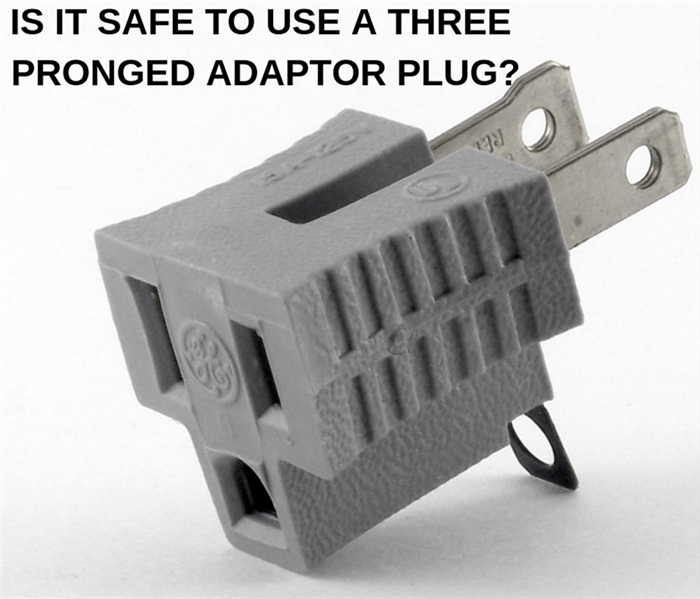 Many old homes lack 3 slotted grounding outlets. An easy solution is to use a cheater plug but are they safe?
Many old homes lack 3 slotted grounding outlets. An easy solution is to use a cheater plug but are they safe?
We were once called to a home that had experienced a devastating fire. The rental home had been an older house that fortunately vacant at the time of the fire. After the investigation was concluded, it was determined that the fire had been started by an extra freezer that had been put in the garage. The problem? The garage did not have any three pronged outlets so the tenant had used a three-pronged adaptor plug to circumvent this obstacle.
Three pronged adaptors, also known as "cheater plugs", allow a three pronged plug to connect to a non-grounded, 2 slotted receptacle. They are often used for appliances in older homes and they solve the problem without any electrical work being necessary. However, as seen in the case above, they are not designed to be a safe solution. The reason appliances and electrical items have a third plug is to protect them from electrical surges, malfunctions and fire. If something goes wrong with the appliance, the cord, or the outlet, the ground system provides a secondary path for the electricity, leading it back to your home's breaker box and safely into the earth. Taking away that grounding function makes your home vulnerable to a fire.
It is safer choice to replace your outlets with a third prong outlet and while you are at it, make it a GCFI outlet. GCFI outlets shut the electricity to the appliance off at the outlet when a surge is detected, rather than the breaker as is the case of a 3 pronged outlet. This saves seconds, which could protect your appliance, your home and you from a shock!
In the New Haven County area, we have many beautiful old homes that are lacking updated electrical systems. We are also fortunate to live in an area with a plethora of talented electricians. Give one a call to inspect your older home for any potential issues and protect your property from an electrical fire.
Home Restoration After Oil Burner Puffback in New Haven County
1/15/2019 (Permalink)
 The tell tale sign of a furnace puff back are the soot cobwebs found in the corners of a room.
The tell tale sign of a furnace puff back are the soot cobwebs found in the corners of a room.
We were called this week to a job at a home that had been hit by a puffback. In our conversation with the homeowner, they expressed surprise that they had never heard of a puffback before.
Although not an everyday occurrence, we receive several restoration calls a year from homeowners who have had a furnace puffback. A puffback occurs when the oil burner malfunctions. This can be because the burner doesn’t ignite immediately and a buildup of fumes causes an explosion similar to that of a car backfiring. Puff backs can also happen when debris builds up and causes an explosion when the boiler turns on. In either case, the explosion sends soot and debris through the furnace or boilers exhaust system and into your home. In our experience, the soot tends to be more widespread in forced hot air systems as the heating ducts spread the soot with same efficiency that they spread air throughout the home.
A puffback leaves a fine layer of oil based soot on all of the surfaces of a home. This includes hard surfaces such as floors, walls and furniture as well as soft furnishings such as curtains, bedding, clothing and carpeting. In fact, because it is literally blasted throughout your house, the soot from a puffback manages to find its way into every nook and cranny.
When you’ve had a puffback, you will know it!
You may first notice a black sticky film on your countertops and then realize that it is widespread throughout your home. Some homeowners will see what appears to be black spiderwebs in the corners of your rooms - this is a common way the soot collects and settles.
Attempts to remove the soot will prove futile and possibly make the damage worse. Because of its oil based nature, the residue left after a puffback requires professional restoration. The SERVPRO of Milford-Orange-Stratford team is experienced, trained and equipped to properly clean your home and it’s contents of oil and soot. The good news is that puffbacks are typically covered under your homeowners insurance policy. When you experience a puffback, call your oil burner specialist, your insurance agent and SERVPRO of Milford-Orange-Stratford for immediate service.
Keep Your Thanksgiving Disaster Free With These Tips
11/21/2018 (Permalink)
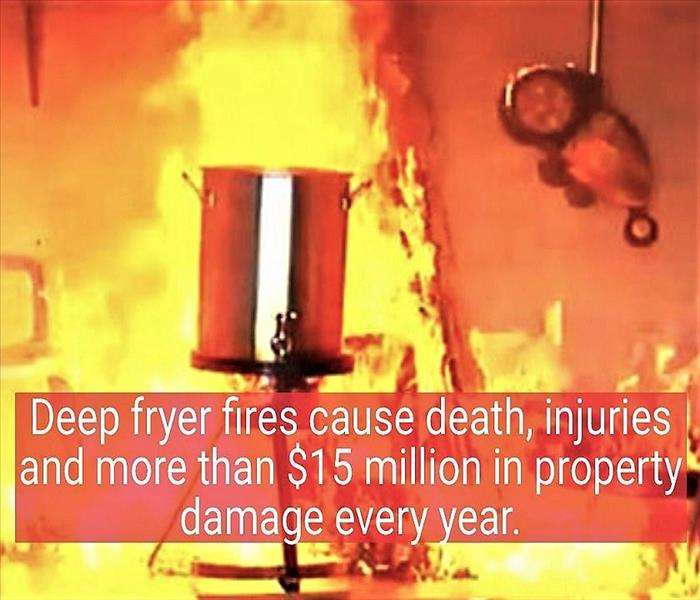 Thanksgiving is the most common day of the year for kitchen fires - deep fryers being the number one culprit.
Thanksgiving is the most common day of the year for kitchen fires - deep fryers being the number one culprit.
Thanksgiving is a day filled with family, parades, football and, of course, food! The kitchen is the heart of home, especially during the holidays when most of us in New Haven County are preparing a meal with many more recipes, in larger quantities and with more cooks in the kitchen than usual!
Unfortunately, Thanksgiving Day also has the highest number of home fires annually. In 2013, Thanksgiving Day had 1,550 reported kitchen fires, which is 230% above the average number of fires per day. Keep these kitchen safety reminders in mind as you prepare your Thanksgiving feast!
"Be on time"
With so many things on your "to do" list, guests coming and going and multiple items cooking, be sure to set timers so that you don't remember to take something out of the oven too late! (nobody likes their stuffing THAT dry!)
“Stand by Your Pan”
Have a designated cook in the kitchen at all times so that food is not left unattended. This is the most common source of kitchen fires. It only takes a moment for a kitchen fire to start and with a vigilant cook in the kitchen, catching it immediately is the key to avoiding the fire spreading.
"If you fry, don't make it too high!"
The popularity of deep frying the turkey has soared (We at Milford-Orange-Stratford haven't gone this route because we are traditionalists but we hear it's quite delicious!). An overfilled cooking pot will cause cooking oil to spill when the turkey is put in, and a partially frozen turkey will cause cooking oil to splatter when put in the pot. Even a small amount of cooking oil spilling on a hot burner can cause a large fire. Play it safe and fry your bird outside.
"For grease fires, water makes it go higher!"
Never attempt to extinguish a grease fire with water or a wet towel. Water will cause the flames to flare up and spread quickly. Turn off the stove and cover the fire with a lid if it is safe to do so, thereby removing the oxygen from reaching the fire. Use a fire extinguisher, which should be stored in a convenient kitchen location (not hidden under the kitchen sink!) If you do not have a fire extinguisher, baking soda is also effective at putting out grease fires however you do need to use quite a bit of it.
We wish all of you a Happy Thanksgiving!
How to Use the Fire Extinguisher in Your New Haven County Home
10/4/2018 (Permalink)
Most of us have at least one fire extinguisher in our Connecticut homes as well as in our schools and workplace. According to FEMA, the majority of Americans don’t know how to use an extinguisher. This is a dangerous statistic given that fires can double in size every 60 seconds. You don’t want to be frantically reading a manual while the a stove top fire spreads throughout your kitchen. While operating one is not difficult, there are a few key rules that you should know.
Fire extinguishers are categorized by a variety of classes based on the type of fire they are formulated to extinguish. Most fire extinguishers for homes and public spaces are classified as Class ABC extinguishers, meaning they’re suitable for putting out wood and paper fires, flammable liquid fires, and electrical fires. If you work in a commercial kitchen, your extinguisher is most likely a Class K.
Class A – Ordinary solid combustibles like wood, cloth, and paper products.
Class B – Flammable liquids and gases.
Class C – Electrical fires. (Do not use water to put out this kind of fire – you could get electrocuted!)
Class D – Flammable metals.
Class K – Oils and grease fires. (Never use water on a grease fire – it will cause the flames to explode and spread.)
If you have a fire in your home, a good rule of thumb in determining whether a fire extinguisher will be effective on it is the height of the fire. If the fire is taller than you, your extinguisher most likely will not be able to extinguish the fire and it is recommended that you vacate the premises and dial 9-1-1.
If you are taller than the fire, position yourself in a location where you can make an exit if necessary and confirm that you have the right type of extinguisher for your fire.
According to the U.S. Fire Administration, the best way to remember how to use a fire extinguisher is by remembering the acronym "PASS".
Pull the pin.
Aim the nozzle at the base of the fire. Hitting the tops of the flame with the extinguisher won’t be effective.
Squeeze the trigger. In a controlled manner, squeeze the trigger to release the agent.
Sweep from side to side. Sweep the nozzle from side to side until the fire is put out. Keep aiming at the base while you do so. Most extinguishers will give you about 10-20 seconds of discharge time.
Slowly back away. Even if the fire appears to be extinguished, don’t turn your back on it. There might be unseen hot spots or hidden fires that can ignite into a large flame at any moment.
Once you’ve used a fire extinguisher, even if you didn’t deplete all the pressure, you must get it recharged.
If your Woodbridge, CT home has a fire, SERVPRO of Milford-Orange-Stratford has the experience to clean up fire extinguisher residue as well as water and fire damage. Call us at (203) 301-0500 for a quick response and professional service.
Keep Your 4th of July Festivities Safe With These Fireworks Tips
6/28/2018 (Permalink)
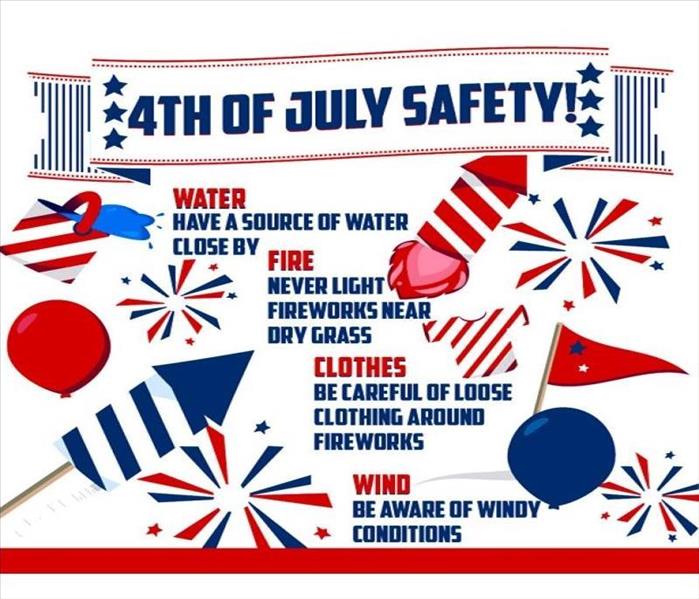 Fireworks cause fire damage to homes and buildings and injuries to people each year. If you choose to use fireworks at home, follow these safety tips.
Fireworks cause fire damage to homes and buildings and injuries to people each year. If you choose to use fireworks at home, follow these safety tips.
With the 4th of July around the corner, we have already started hearing fireworks being set off in our Stratford area neighborhoods. Let's face it, it's hard to resist picking up a few things that go bang and some sparklers for the kids. At the risk of sounding like a killjoy, we do want to remind our customers that fireworks, and even sparklers, cause quite a bit of damage and bodily injury each year.
In fact, according to the National Fire Protection Association, fireworks start an average of 18,500 fires per year. This includes 1,300 structure fires, 300 vehicle fires and 16,900 outdoor fires. The NFPA recommends that you leave fireworks to the professionals however if you want to set a few off in your driveway, here are a few tips to keep it safer.
- Alcohol and fireworks do not mix. Save your alcohol for after the show.
- Wear safety glasses when shooting fireworks.
- Light one firework at a time and then quickly move away.
- Use fireworks OUTDOORS in a clear area; away from buildings and vehicles.
- Never relight a “dud” firework. Wait 20 minutes and then soak it in a bucket of water.
- Always have a bucket of water and charged water hose nearby.
- Never carry fireworks in your POCKET or shoot them into METAL or GLASS containers.
- Do not experiment with homemade fireworks.
- Dispose of spent fireworks by wetting them down and place in a metal trash can away from any building or combustible materials until the next day.
Adults should always handle fireworks. Although sparklers are fun, they account for roughly one quarter of fireworks injuries. If you give kids sparklers, make sure they keep them outside and away from the face, clothing, and hair. Sparklers can reach 1,800°F (982°C) — hot enough to melt gold. Kids are also drawn to investigate the used pieces of fireworks that lie on the ground after an event. Discourage this, as some may hot and even still be ignited and can cause burns.
Pet safety is also a concern on the 4th of July. Think about your pet. Animals have sensitive ears and can be very frightened or stressed by the noise that fills the day. Don't bring your dog to the barbecue – they are happier and safer if left inside. Create a comfortable place inside your home for your pet. Finally, make sure your pet has accurate identification tags on them in case they run away because of the loud noises.
Whether you choose to stay at home or go to a public fireworks show, stay safe and have a great time!
Fire Safety When Grilling This Summer in New Haven County
6/6/2018 (Permalink)
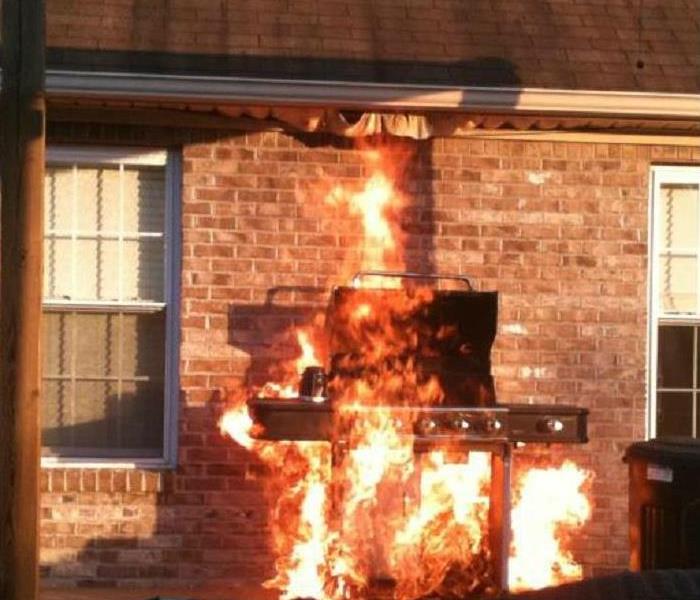 Although this house is brick, it was still not safe to cook on the grill this close! The fire was able to reach the vinyl overhang and catch.
Although this house is brick, it was still not safe to cook on the grill this close! The fire was able to reach the vinyl overhang and catch.
Finally! Summer is arriving and we are all excited for barbecues, the beach, camping and fireworks. Nothing says summer like late nights around a fire pit with friends. Summer brings fun activities but we should also be aware of the increased risk of fire during these months. Awareness of the risks and taking caution when participating in fire related activities will keep your summer safe.
Grill Fires
Grilling is our favorite way to cook in the summer. Barbecued food tastes delicious, grilling keeps the heat outside on a hot summer day and there are no pots to clean afterwards. It's a win-win-win if it all goes right. However, 5,700 home related grill fires occur each year – the majority of which occur between May and August.
Take preventative measures by:
- Inspecting your grill’s condition before the grilling season begins. Clean the grill, the drip pan, and anything that could have grease on it from previous barbecue dinners. Inspect each part of your barbecue to make sure everything is attached properly.
- Make sure that your grill is a safe distance from your house – 10 feet is recommended. I've personally experienced how quickly the vinyl siding on a home can melt from a barbecue. Do not use the grill in a garage, breezeway, carport, porch, or under a surface that can catch fire.
- Be prepared for a fire, as grease and fat are likely to catch on fire. Keep baking soda in a waterproof container near the grill in case a grease fire breaks out.
Air Conditioning Fires
According to the National Fire Protection Association, in 2010, air conditioning, fans or related equipment were involved in an estimated 7,400 reported U.S. home structure fires, with associated losses of 29 civilian deaths, 249 civilian injuries and $207 million in direct property damage. These fires usually begin with the ignition of a wire or cable insulation. It’s not just the AC that catches on fire, if your AC heats up, flammable materials near your unit can catch on fire. Fires are most likely to occur when it’s hottest outside—between 2 and 8 p.m.
- Inspect your air conditioner’s wiring systems each year to prevent these types of fires. Consider the safety concerns of purchasing an older or used air conditioning unit.
- Also, find ways to use the AC less during the day. Not only will you save money, you can save your home from a potential fire. Using fans, keeping windows open during the night, and closing blinds during the day are just some ways you can keep your house cool without AC.
We're looking forward to seeing everyone out at the beach and grilling out in Milford this summer! Stay safe and have fun!
When Fire and Water Take Control of Your Life, We Help You Take it Back!
1/8/2018 (Permalink)
Mitigation requires quick action. The faster SERVPRO of Milford-Orange-Stratford arrives on-site to perform fire, smoke, and soot cleanup and restoration, the better the results—including lower claim costs. Within four hours of loss notification, we will be on-site to help ensure that fire damages are handled by utilizing the following services.
- Structural Cleaning - After a smoke or fire damage, ceilings, walls, woodwork, carpeting, and floors will often need a thorough cleaning. We will pretest to determine the extent of damage, then use the specific equipment and cleaning products required to clean and protect the different types of surfaces found in your insured’s structure.
- Contents Cleaning - All of the restorable contents in affected areas will be professionally cleaned and deodorized. This includes area rugs, furniture, draperies, and upholstery. Additionally, all the other restorable contents will be cleaned and deodorized to pre loss condition. This includes electronics, art, wood furniture, kitchen items, clothing, bedding, and much more. Finally, we can provide an inventory list of all “to be claimed” items for your insured.
- Deodorization - We provide specialized services that rid your residence or business of offensive odors left by fire or smoke damage. We do not cover up lingering odors with a fragrance. We seek out the sources of the odor and remove them.
Safety Tips - Candles
1/4/2018 (Permalink)
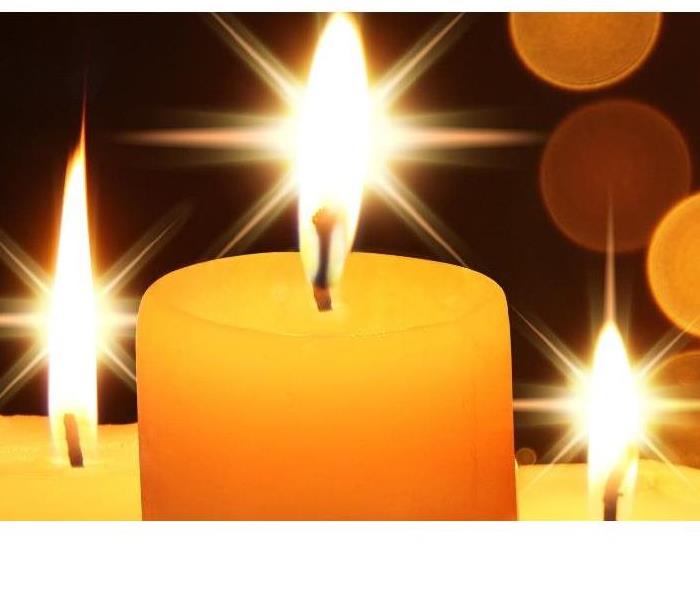 Keep Candles At Least a Foot Away From Anything That Can Burn.
Keep Candles At Least a Foot Away From Anything That Can Burn.
Holiday Safety Tips:
Candles, pretty lights and decorations are just a few of the items that add to the charm and cheer of the holiday season, however, if they are not used carefully your holidays may go from festive to frightening very quickly.
Below are safety tips provided by the National Fire Protection Association, to greatly reduce the fire risk in your home this holiday season.
Two out of five home decoration fires are started by candles. Keep candles at least three feet away from anything that burns.
Use sturdy candle holders that are not likely to tip over and place candles on clear, uncluttered surfaces.
Never leave candles unattended.
Consider using flameless candles instead of real candles.
Make sure you have the correct type of light for your desired décor. Some lights are designed for only indoor or outdoor use, but not both.
Carefully inspect light strands before placing them. Replace any string of lights with worn or broken cords or loose bulb connections. Connect no more than three strands of light sets.
Get rid of your tree after Christmas or when it is dry. Dried-out trees are a fire danger and should not be left in the home or garage. Check with your local community to find a recycling program.
Remember to turn off outside decorative lights and Christmas tree lights before leaving or going to bed.
Bring outdoor electrical lights inside after the holidays to prevent hazards and make them last longer.
Smoke alarms save lives! Install smoke alarms on each level of your home, near kitchen and sleeping areas. Don’t forget to replace all batteries at least once a year.
SERVPRO of Milford-Orange-Stratford wishes you a safe and happy holiday season!
What are the Different Types of Smoke?
1/3/2018 (Permalink)
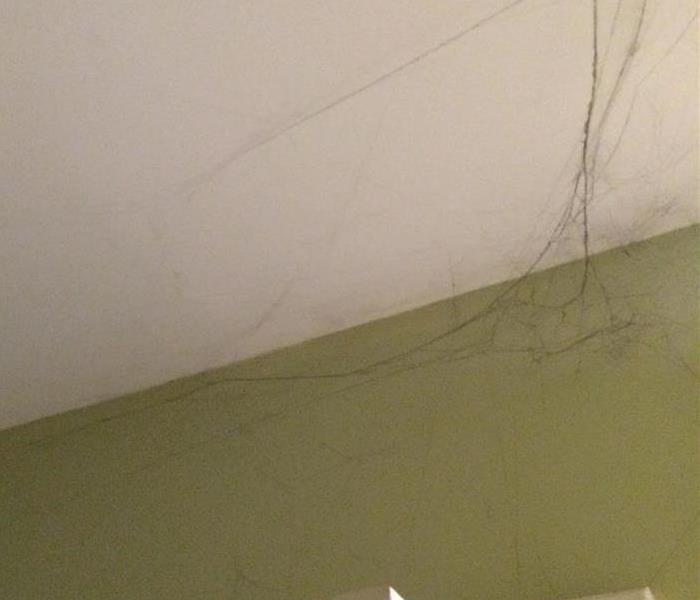 An example of soot webs from a puff back.
An example of soot webs from a puff back.
Some of the different types of smoke are:
Fuel Oil Soot – Furnace puff backs
Wet Smoke – Plastics and rubbers low heat, smoldering, pungent odor, sticky, smeary.
Dry Smoke – Paper and wood fast burning, high temperatures, heat rises therefore the smoke rises.
Protein – Produced by evaporation of material rather than from a fire. Virtually invisible, discolors paints and varnishes, extreme pungent odor.
Other Types – Tear gas, fingerprint powder and fire extinguisher residue.
As we enter into the colder months and turn up our thermostats, one of the common types of smoke is fuel oil soot released from your furnace, called a “puff back.”
A puff back is a different type of smoke, a sudden dispersion of black smoke and soot throughout the house. Another identifier can be the appearance of cobwebs, but are actually “soot webs” which are much darker and has an oil odor present. The oil base soot disperses throughout one’s home affecting walls, ceilings, carpets and furniture to name a few. It is extremely difficult to remove and there may be a foul odor in the affected rooms.
The cause for a puff back may vary from age of boiler, lack of maintenance, failure to make needed repairs and/or a malfunction. All heating systems, especially oil-fired, should be inspected, cleaned and adjusted at least once a year by a qualified professional.
Should the unexpected happen, clean-up should be handled by a professional cleaning company like SERVPRO of Milford-Orange-Stratford.
The Importance of Dry Vent Cleaning:
11/17/2017 (Permalink)
The Importance of Dry Vent Cleaning:
According to FEMA, failure to clean home dryers causes 34% of home dryer fires. Home dryer fires cause $35 million in property loss and can even cause injury or death. To reduce the risk of these fires happening in your home, SERVPRO of Milford-Orange-Stratford can help clean dryer vents and ducts that may have lint buildup. Other tips for keeping your dryer vents clean from the National Fire Protection Agency include cleaning the lint filter before and after each load and making sure the outdoor vent flap stays open and that it is not restricted by snow, a bird’s nest, or other potential obstacles. For more information on cleaning dryer vents, call SERVPRO of Milford-Orange-Stratford at 203-301-0500 or visit us at http://www.SERVPROmilford-orange-stratford.com/.
Safety Precautions For This Heating Season
11/16/2017 (Permalink)
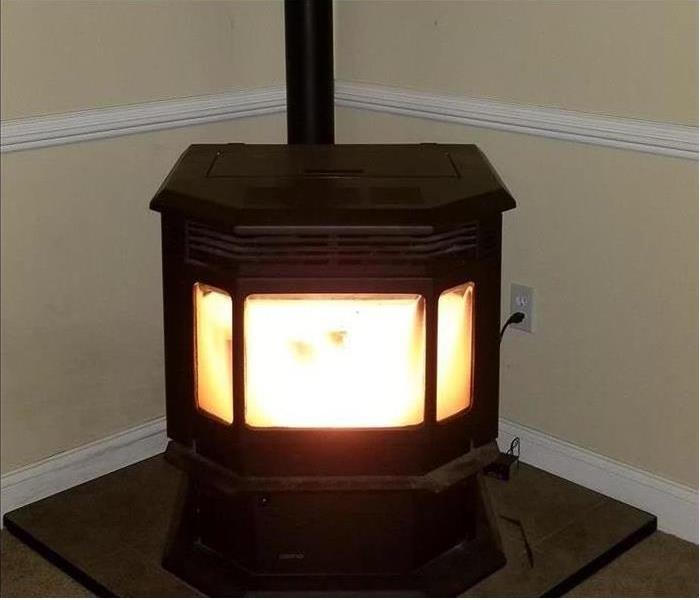 Pellet Stove
Pellet Stove
Winter is upon us and with colder weather comes shorter days and lower temperatures! Many people use alternative heating sources like fireplaces, portable space heaters, pellet and wood burning stoves to help keep their homes toasty. Did you know, heating equipment is a leading cause of home fire deaths? According to the National Fire Protection Association, heating equipment fires account for $1 billion in direct property damage annually. Keep the following safety tips in mind to help reduce risk heating-related fires:
- Keep flammable items at least three feet away from heating equipment like furnace, fireplace, wood stove, or a portable space heater.
- Have a three foot “kid-free zone” around open fi res and space heaters.
- Be sure that your fireplace has a screen in front of it to help stop sparks from flying into the room.
- Ashes should be cool before putting them in a metal container. Keep the metal container a safe distance away from your home.
- Remember to turn portable heaters off when leaving the room or when going to bed.
- Test smoke alarms monthly and change batteries annually.
- Always use the right kind of fuel, specified by the manufacturer, for fuel burning space heaters.
- Heating equipment and chimneys should be inspected every year by a qualified professional.
Should your property experience smoke or damage, SERVPRO of Milford-Orange-Stratford is here to make it, “Like it never even happened.”
Smoke Alarms Save Lives!
11/16/2017 (Permalink)
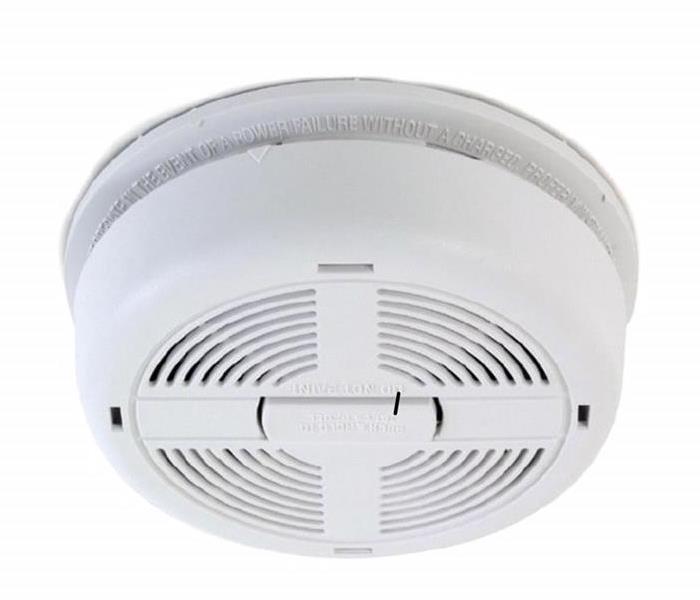 Smoke Alarm
Smoke Alarm
Smoke alarms save lives when properly installed and maintained, according to the National Fire Protection Association (NFPA). In homes, smoke alarms should be in every bedroom, outside each sleeping area, and on every level, including the basement. Extra smoke alarms may be needed in large homes. Test smoke alarms monthly using the test button. Smoke alarms with non-replaceable batteries need the entire smoke alarm unit replaced every ten years. Other alarms need batteries replaced every year, and the unit replaced every ten years. If the alarm chirps signaling low battery, take the proper steps to replace the unit or the batteries immediately. Never disable or remove the battery from an alarm. Almost half of fires where smoke alarms were present but did not activate had missing or disconnected batteries (NFPA). If you need help installing, testing or changing batteries in your smoke alarms, contact your local fire department, an electrician or the American Red Cross. Be sure your home has a fire emergency plan in place and conduct regular fire drills with your family. For more information on how smoke alarms save lives, visit http://www.nfpa.org/.
Did You Know That There Are Different Types Of Smoke?
12/28/2016 (Permalink)
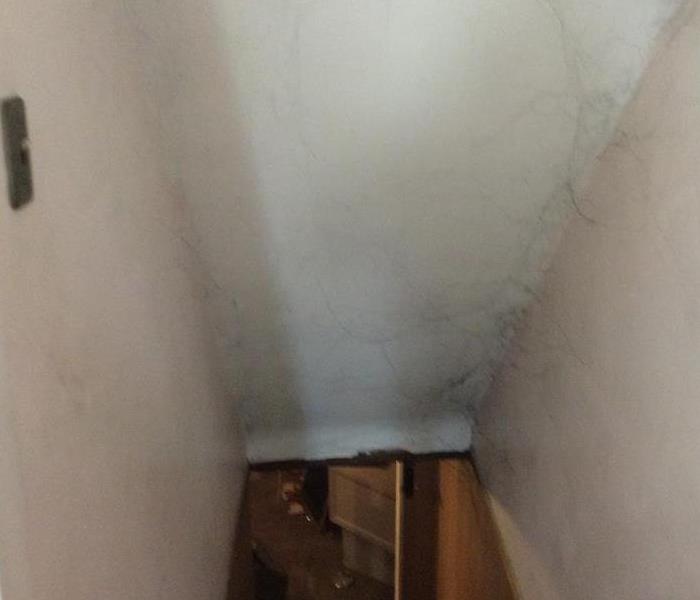 An example of soot webs (aka cobwebs).
An example of soot webs (aka cobwebs).
Some of the different types of smoke are:
Fuel Oil Soot – Furnace puff backs
Wet Smoke – Plastics and rubbers low heat, smoldering, pungent odor, sticky, smeary.
Dry Smoke – Paper and wood fast burning, high temperatures, heat rises therefore the smoke rises.
Protein – Produced by evaporation of material rather than from a fire. Virtually invisible, discolors paints and varnishes, extreme pungent odor.
Other Types – Tear gas, fingerprint powder and fire extinguisher residue.
As we enter into the colder months and turn up our thermostats, one of the common types of smoke is fuel oil soot released from your furnace, called a “puff back.”
A puff back is a different type of smoke, a sudden dispersion of black smoke and soot throughout the house. Another identifier can be the appearance of cobwebs, but are actually “soot webs” which are much darker and has an oil odor present. The oil base soot disperses throughout one’s home affecting walls, ceilings, carpets and furniture to name a few. It is extremely difficult to remove and there may be a foul odor in the affected rooms.
The cause for a puff back may vary from age of boiler, lack of maintenance, failure to make needed repairs and/or a malfunction. All heating systems, especially oil-fired, should be inspected, cleaned and adjusted at least once a year by a qualified professional.
Should the unexpected happen, clean-up should be handled by a professional cleaning company like SERVPRO of Milford-Orange-Stratford, to make it "Like it never even happened."
Grilling Safety Tips:
7/14/2016 (Permalink)
 Hamburgers - photo by Carlos Lopez
https://www.flickr.com/people/7632976@N02
Hamburgers - photo by Carlos Lopez
https://www.flickr.com/people/7632976@N02
Grilling Tips:
There is nothing like firing up the grill during the summer months! Did you know July is the peak month for grill fires? A backyard barbecue can become dangerous if safety precautions aren’t considered.
· Propane and charcoal BBQ grills should only be used outdoors
· The grill should be placed away from the home, deck railing and out from under leaves and overhanging branches
· Keep children and pets away from grill
· Keep your grill clean by removing grease buildup form the grills and in trays below the grill
· Never leave grill unattended
· When using a charcoal grill, let the coals completely cool before disposing in a metal container
We at SERVPRO of Milford-Orange-Stratford wish you a Happy and Safe Grilling Season!
4th of July Safety Tips:
6/27/2016 (Permalink)
4th of July Safety Tips:
Summer is in full swing with barbecues, parades and firework displays; but along with all the festivities are visits to emergency rooms, especially during the month of July.
Each year, an average of 23 people are injured due to fireworks-related incidents, according to the U.S. Consumer Product Safety Commission. Also, fireworks are responsible for thousands of house fires each year with millions of dollars in property damages.
Consider the following tips to ensure your 4th of July celebrations are disaster-free!
· Light fireworks outdoors on a driveway or other paved surface(s) at least 50 feet away
· Avoid lighting fireworks near home and away from flammable materials (dry grass or mulch)
· Anyone using fireworks or standing nearby should wear protective eyewear
· Do not try to re-light or handle malfunctioning fireworks
· Keep a bucket of water nearby to fully extinguish fireworks that don’t go off or in case of fire
· Never pick up left over fireworks as they may still be active
· The safest way to enjoy fireworks is to attend a public display conducted by trained professionals
SERVPRO of Milford-Orange-Stratford wishes you a Happy 4th of July and a Safe Summer!





 24/7 Emergency Service
24/7 Emergency Service
